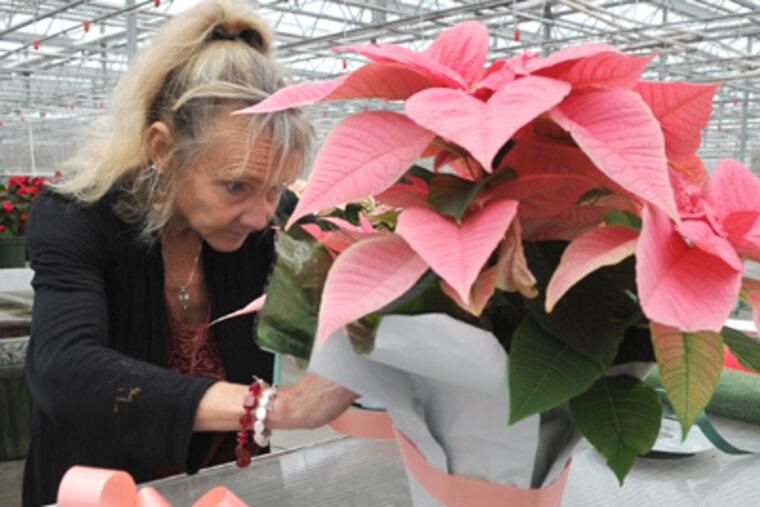Poinsettias' Phila. roots
Hardy Christmas flower got its U.S. start in 1829 at the first Flower Show.

The red poinsettia has been a Christmas tradition forever, it seems. Did you know it has a historic connection to Philadelphia?
Bartram's Garden, established on the banks of the Schuylkill around 1728 by botanist John Bartram, was the first to successfully grow the poinsettia outside its native Mexico. Bartram's officially introduced it to the American public and commercial trade at the inaugural Philadelphia Flower Show on June 6, 1829.
At this one-day affair, the public reacted to the poinsettia and hundreds of other plants with such excitement that the show's host, the fledgling Pennsylvania Horticultural Society, decided to make it an annual event.
The exotic Mexican beauty was described as "a new Euphorbia with bright scarlet bracteas, or floral leaves, presented to the Bartram collection by Mr. Poinsett, United States Minister to Mexico." "Mr. Poinsett" was Joel Roberts Poinsett, a prominent South Carolina politician and diplomat with an interest in horticulture.
Nevertheless, according to historian Joel T. Fry, it was not Bartram's that became known as the poinsettia's patron. English garden historians bestowed that honor on Philadelphia nurseryman Robert Buist, who introduced it to his Scottish homeland in 1834, fully five years after the flower show.
"Even though something new might be discovered, Bartram's didn't sit around recording each one," Fry said.
As opposed to the Brits, who did.
Late in life, Buist corrected the record. He wrote an article describing his presence at Bartram's when "two plants with stubby little roots were unpacked. They turned out to be poinsettias," Fry said.
From the get-go, the now oh-so-familiar poinsettia was the province of botanists, "plant nerds," and wealthy hobbyists, according to Paul Ecke 3d, whose great-grandfather Albert Ecke started the family's poinsettia business in Los Angeles a century ago.
"Nobody else had the money to heat their house to keep the flowers alive, and certainly not a greenhouse," Ecke said.
For decades, the poinsettia was field-grown and sold as a cut flower, like roses. In the 1960s, the Eckes moved their growing operations indoors, commercial breeding began in earnest, and potted plants quickly superseded cut stems as the norm.
With aggressive marketing, poinsettias soon became "the Christmas plant," which is an honest claim; their natural bloom time is winter.
Today, besides the ubiquitous red, poinsettias come in lots of colors, even yellow, and designs, including marbled, painted, and glittered. Ecke has a new early-bloomer he promotes for outdoor landscapes in places such as Texas and California.
Remarkably, red is still the public's favorite color. "It's the tradition," he says.
But the poinsettia industry struggles to attract a younger audience - with novelty and supersized plants, as well as specimens sold in "cool pots that promote lifestyle."
"We don't want poinsettias to just be Grandma's plant or Mom's plant. We have to make poinsettias cool for Gen XYZ," Ecke said.
About 120 million poinsettias are grown annually in this country, according to the U.S. Department of Agriculture. And while they're still "the Christmas plant," they're no longer the most popular potted plant in America.
Orchids are.
Still, Ecke doesn't complain. The family business, which moved to Encinitas, Calif., in 1923 and expanded to Guatemala in 1995, still controls 70 percent of the worldwide market in poinsettia cuttings, 50 percent of the domestic.
As for "Mr. Poinsett," turns out he was vain and opinionated and caused such a scandal in Mexico, he was eventually kicked out. Today, Fry said, "he is always portrayed as an evil American gringo."
As if that weren't grinch-y enough: In papers left behind, Poinsett never once mentions the curious plant that set Philadelphians on their head in 1829.
Said Fry: "It was not a big thing in his life."